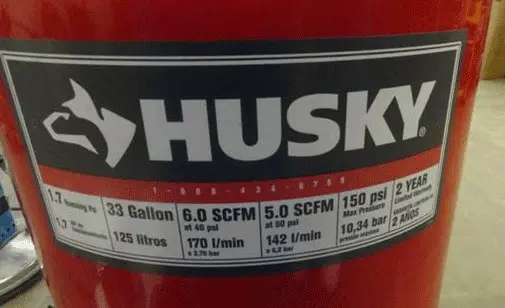SCFM and CFM are two technical units for measuring gas. People often struggle to truly know the differences between the two, and so, this article will provide you with all the relevant information on both measurements and their key differences.
Table of Contents
- What is CFM?
- What is SCFM?
- CFM vs SCFM: What Are the Differences?
- Converting CFM to SCFM
- FAQs (Frequently Asked Questions)

What is CFM?
CFM is a measurement of airflow stands for Cubic Feet per Minute. A lot of confusion is often found around this measurement because it does not have a single definition that applies to all situations. CFM describes the volume of air that occurs at a certain pressure or temperature.
What is SCFM?
SCFM stands for Standard Cubic Feet per Minute. It is specified as the molar flow rate of air or gas, that is subjected to standardized conditions (pressure and temperature). SCFM is related to the mass flow rate of a gas by a multiplicative constant which only depends on the molecular mass of the gas.
CFM vs SCFM: What Are the Differences?
In the United States, air-flow volume is typically measured in cubic feet per minute (CFM), and this is the same across most countries. It doesn’t matter whether the air is coming from an air compressor, blower, or a fan, the rate of the air is going to be measured in volumetric terms, to account for the amount of air that is able to pass within a certain measurement of time.
On air compressors, CFM and SCFM are two of the most common ratings that are used to indicate the capabilities of a given make and model of compressor. One main difference is of course their full forms, CFM stands for cubic feet per minute while SCFM stands for standard cubic feet per minute. CFM will always be a lower rating than the SCFM rating because SCFM is calculated at a lower pressure which makes the air volume larger.
CFM is typically measured at a point where the air supply is pressurized, usually at 90 PSI. A few more factors will need to be taken into consideration to determine a compressor’s SCFM rating, which is generally impacted by temperature, humidity, and pressurization. And so, the SCFM rating of a given air compressor will be a higher number than its CFM counterpart.
CFM doesn’t use standardized units for its calculation, while SCFM has set pressure, temperature, and volume standards for its calculation. As mentioned, CFM values are taken under the pressure of 90 PSI, or thereabout, whereas air is expanded to a standard condition of around 14.7 PSIA (atmospheric pressure) to calculate SCFM.
SCFM is more indicative of how the gas which is pressurized to a standard value will perform at the endpoint applications, while CFM tends to be more relevant to the internal capacity of an air compressor.
SCFM tends to be the more preferred measurement of the unit as it uses standardized temperature, volume, and pressure, which provides are the more precise result.
| Parameters of Comparison | CFM | SCFM |
|---|---|---|
| Full Name | Cubic Feet per Minute | Standard Cubic Feet per Minute |
| Standardization | There are no standard conditions at which the CFM values should be calculated. | Must be standard pressure, volume, and temperature at which SCFM should be calculated. |
| Measurement | CFM is calculated at higher pressure which makes the air volume smaller, and so, CFM is always a smaller number than SCFM. | SCFM is calculated at a lower pressure which makes the air volume larger, and so, SCFM is always a bigger number than CFM. |
| Calculation | Pressure is maintained under 90 PSI to calculate CFM values. | Air is expanded to a standard condition of 14.7 PSI to calculate SCFM. |
| Indication | CFM is relevant to the internal capacity of an air compressor. | SCFM is more indicative of how the gas (pressurized to a standard value) performs at the end point. |
Converting CFM to SCFM
Different industries and companies will use slightly different standard conditions and argue they are not what is commonly used, but we will ignore that discussion. CFM and SCFM are stated as:
CFM = Cubic Feet per Minute = ft.3/minute at actual conditions
SCFM = Standard Cubic Feet per Minute = ft.3/minute at standard conditions (1 atm = 14.7 PSI & 68°F)
The volumetric flow rate with units of CFM implies that the flow rate is measured at actual conditions (pressure and temperature). The distinction between SCFM and CFM is crucial because air density will understandably change with pressure and temperature.
You can see this by looking at the ideal gas law. Density is equal to mass divided by volume, and so, you can rearrange the ideal gas law so that the air density is proportional to pressure and inversely proportional to temperature.
PV = mRT → ρ = m/V = P/RT
Air density at standard conditions = 0.0752 lb./ft3
Since the air density of an airflow stated at standard conditions (SCFM) will always be the same, it is essentially a mass flow rate. Stating an airflow in units of SCFM makes it a lot easier to compare conditions, and certainly calculations.
ρ = m/V → m = ρV →m/t = ρ (V/t)
mass flow rate = density * volumetric flow rate
With this in mind, we can easily derive the conversion equation from the ideal gas law and the mass flow rate equations presented above. The mass flow rate is equal regardless of the flow being stated in CFM or SCFM.
m/t = ρactual*CFM = ρstd*SCFM →
SCFM = CFM *(ρactual/ ρstd) = CFM * (ρactual/Pstd)*(Tstd/Tactual)
Giving that the ideal gas law uses absolute pressures and absolute temperature scales we are left with:
SCFM = CFM * (Pactual/14.7psi)*(528°R/Tactual)
FAQs (Frequently Asked Questions)
Yes, SCFM is always a higher value than CFM because CFM is calculated at a higher pressure of around 90 PSI compared to SCFM being calculated at a standard pressure of 14.7 PSI (1 ATM). This means that CFM has a smaller volume due to its higher pressure, and so, is a lower number than SCFM.
No, although they’re both technical units for measuring gas, CFM and SCFM are different because they use different sets of parameters for their calculations. SCFM is based on a standard set of conditions while CFM has no standard set of conditions. CFM is more relevant to the internal capacity of an air compressor at 90 PSI while SCFM is indicative of how air performs at the endpoint applications when pressurized to a standard value.
In order to gauge the minimum amount of compressor SCFM you need, you must examine the SCFM ratings of all the tools you intend to power, and multiply the highest tool rating by 1.5 to get your minimum SCFM needs.
If you have any questions about CFM vs SCFM ratings, please comment below, so then someone can help you!


